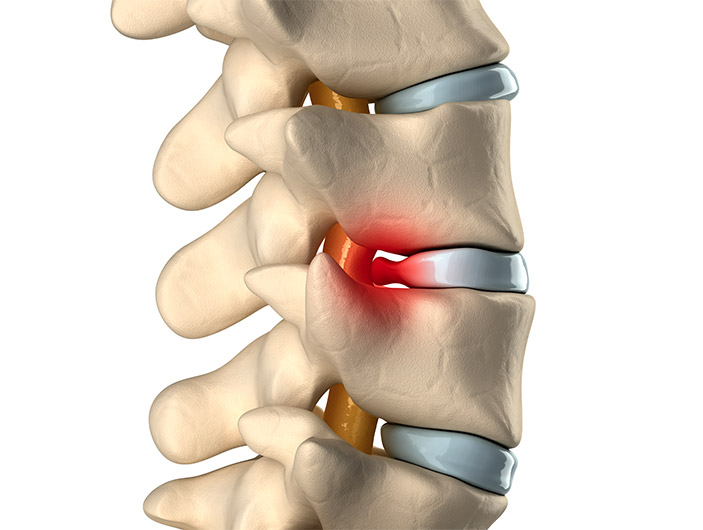
Your back is one of the most complex and sensitive areas of your body, so it isn’t surprising that back pain is one of the most common health issues. Back pain may come in many forms, from pulled muscles to pinched nerves or bone fractures. A myriad of things can go wrong with the back, and many of them alert you to their presence by causing pain.
One of the more common back issues involves spinal discs which are the cushiony tissue found between spinal vertebrae. When something goes wrong with a spinal disc, it can allow bones to come into contact with one another or compress on a spinal nerve. For anyone who has suffered from a herniated or bulging disc, the pain that results can be excruciating.
There are two primary forms of pain that may result from an intervertebral disc condition. The first is pinched nerve pain which occurs when a nerve is compressed or irritated by other tissue. The other kind is disc pain which involves abrasive contact between bones or degeneration of the intervertebral disc itself.
Designing the Human Spine
Your back is a complicated network of muscles, bones, ligaments and nerves that serve a multitude of purposes. Among the most important components is, of course, the spine. Reaching from the skull to the hips, there are 33 bones found in the human spine. This includes 7 in the cervical (neck) region, 12 in the thoracic (upper back), 5 in the lumbar (lower back) region, 5 in the sacral region and 4 in the coccygeal region.
Between the bones making up the spine are the intervertebral discs. These discs are composed of a harder cartilaginous exterior and a jelly-like interior made up of mucoprotein gel. If there is an impact to the spine, the mucoprotein gel re-distributes itself to absorb the shock. As you age, these intervertebral discs often dehydrate, making them more susceptible to tearing and offering less shock absorption.
The spine serves many functions including supporting your upper body and head, but the most important is housing the spinal cord. The spinal cord is the main neural pathway between the brain and peripheral nerves. Nerves from throughout the body travel to the spine and join the spinal cord via tiny passages in the bony spinal column called foramen. If there is damage to these spinal nerves, you may experience one or more of the following symptoms:
- Loss of motor function
- Impaired sensation
- Loss of bladder or bowel control
- Spasms
- Alterations in sexual function
- Pain
- Difficulty breathing
Problems with Spinal Discs
Your intervertebral discs serve an important role in cushioning your spinal bones and protecting nerves, but as you age they can wear down. These discs tend to flatten as you get older, making it more likely that they will tear, deform or shift. If this happens it could compress the spinal cord or other nerve fibers, causing inflammation, pain and infirmity.
You may have heard the terms bulging disc or herniated disc, and thought they are the same condition. While there are many similarities, there are some important distinctions that have a bearing on how they are treated. A bulging disc is a condition in which the disc loses structural integrity and spreads out beyond the boundaries of the spinal column, much like a hamburger patty too large for the bun. This results in pinched nerve pain as it impinges on the spinal cord or other nerves.
A herniated disc, however, involves a tear or crack in the tough cartilage exterior of an intervertebral disc. This allows some of the soft gel to protrude out and may affect some of the surrounding nerves. Because there is more soft tissue exposed in a herniated disc condition, this is more likely to spread farther and cause disc pain than a bulging disc which is fairly localized.
How to Distinguish between a Herniated and Bulging Disc
Whether you are a back pain sufferer or a seasoned medical professional, differentiating between a herniated and a bulging disc can be difficult—sometimes even impossible. Many of the symptoms are identical, so it takes a very experienced clinician to pick up on the subtle distinctions. Both conditions may present with leg or back pain, numbness, and tingling, but these are often more likely in a case of a herniated disc because nerve impingement is more likely.
The only way to confirm a herniated or a bulging disc is to perform an MRI. However, a single imaging scan may not be sufficient to isolate the exact nature of a disc condition; it often takes consultation with a highly experience medical expert to determine the exact nature of the disc pain condition.
Treating a Herniated or Bulging Disc
A herniated or a bulging disc may be painful, but they do not always require medical treatment. If disc pain symptoms arise and your doctor suspects that you have such a condition, then he or she may recommend a short amount of bed rest along with over-the-counter pain relievers like aspirin or Tylenol to remedy the pain and inflammation. In many cases, a herniated or a bulging disc will resolve on its own given enough time.
If your disc pain symptoms don’t improve on their own, your doctor may prescribe other medications. These may include muscle relaxants to calm spasming back muscles or anticonvulsants which have been shown to mitigate nerve pain. In extreme cases, your doctor may prescribe opioid pain killers but only for short periods of time. If inflammation is a big issue, then oral or injected corticosteroids may be used.
In a small number of cases, some patients with a herniated or a bulging disc may be a candidate for a surgical procedure like a discectomy. During this procedure, the protruding portion of the disc is cut away; in more extreme circumstances, the entire disc is removed, necessitating a fusion of the surrounding vertebrae or insertion of an artificial disc.
Article written by: Dr. Robert Moghim – CEO/Founder Colorado Pain Care
M.D. Disclaimer: The views expressed in this article are the personal views of Robert Moghim, M.D. and do not necessarily represent and are not intended to represent the views of the company or its employees. The information contained in this article does not constitute medical advice, nor does reading or accessing this information create a patient-provider relationship. Comments that you post will be shared with all visitors to this page. The comment feature is not governed by HIPAA and you should not post any of your private health information.



